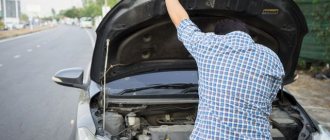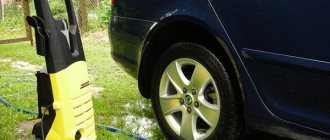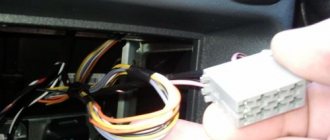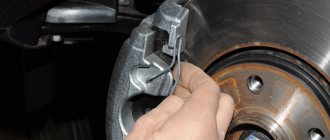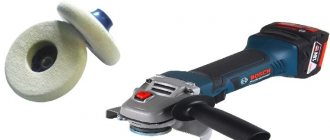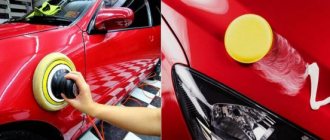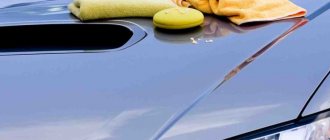Car enthusiasts, purchasing a car from the factory or one that has been used for a short time, can be confident in the reliability and aesthetics of the paintwork. But over time, the beauty of the car is lost due to scratches and tarnishing of the body. Polishing the body protects the car from aging. Compliance with the correct technology ensures high quality of the procedure. Therefore, it is better to contact reputable car services.
Why polish your car and what results can you achieve?
Factory paintwork is difficult to replace. Therefore, it is better to protect it from the following negative influences:
- Ingress of resin or tree sap.
- Foreign paint.
- Bird or animal droppings and claw marks.
- Frequent washing with chemicals that can reduce the protective properties of the coating, reduce the brightness of its color and cause the material to peel off.
- A scratch that appears on the surface of the body makes it vulnerable to corrosion and premature destruction.
Rather than repainting a car, it is better to protect its surface by sanding it. It is enough to apply a transparent layer to the body, protecting the coating from negative external factors. This will slow down the deterioration of the overall appearance. It is better to apply a colorless coat immediately after purchasing the car.
If the vehicle already has mileage, it is worth inspecting the paintwork using the device. It is beneficial to order the procedure along with the repair. This will give it aesthetics without spending extra money. Or you can do it yourself, for this you need to study the best way to polish a car with your own hands.
How to polish headlights
Roughing
After cleaning the lighting device, level the surface with sandpaper. It is pre-soaked for a few minutes. Roughing can be completed if the scratches have disappeared and the entire surface has become matte.
There are some nuances in this work:
- If there are shallow defects on the surface, it is better to first treat it with P 1500 sandpaper. This will preserve the protective coating of the plastic.
- If the damage is serious, then clean it completely, starting with P80 sandpaper. Next, the grain of the paper is gradually reduced.
Independent work consists of progressive movements. Sanding is done longitudinally with one type of sandpaper, and crosswise with another. In this case, be sure to wet the sandpaper with water.
Some craftsmen use a polishing machine for this procedure, which makes the work easier. But this requires care not to overheat the plastic. Grinding is carried out at 600 rpm, constantly wetting the sandpaper with water and moving the tool progressively.
Attention! Do not keep the sander in one place, as the plastic will become cloudy and overheat.
Types of polishing and the best way to polish a car yourself
To achieve the maximum effect, you need to know how you can do this, how best to polish a car, car body with your own hands at home. There are two types of body polishing:
1. Protective – prevents damage, so it is advisable to carry it out immediately after purchasing the car. There are two subtypes: with products containing epoxy resin; with products containing liquid glass - another name for nanopolishing. Protective polishing does not involve the use of abrasive materials. It is best to carry it out in spring or autumn. Protective polishing avoids the following problems:
- fading from ultraviolet sunlight;
- negative atmospheric effects;
- action of an aggressive environment;
- scratches.
Affordable price for polishing using epoxy resin. Nanopolishing occurs when liquid glass interacts with the paint and varnish coating at the molecular level, therefore it is stable, effective, and durable. But the cost of the service is three times higher than the price of traditional polishing with epoxy resin.
2. Restoring (abrasive) – completely or partially restores the paintwork, giving the car a new look. Its essence is in thinning the factory paint, removing several microns. There are two subtypes of restorative procedures: abrasive and soft. It is suitable for heavily damaged paintwork. This type of polishing is labor-intensive and takes place in several stages:
1) removal of the oxidized layer, scratches or other imperfections;
2) applying a coating that restores the surface.
Abrasive polishing of a vehicle should be carried out by specialists. According to service station employees, the owner of the car, who tried to polish the body himself with abrasives, returned the car for a second procedure because the result was unsatisfactory.
You can do this yourself to protect the surfaces. To do this, it is advisable to watch a video on how to properly polish a car by hand. Then you need to buy special chemicals. You can also use a soft cloth or polishing pads to polish your car. The procedure can be performed by a car enthusiast, since no special skills or abilities are required. Enough accuracy and patience.
Criterias of choice
Choosing a polishing unit is not an easy task. There are many different products on sale: large and small, professional and amateur, expensive and cheap. Therefore, it is quite difficult to navigate correctly and choose the right tool without deciding on the criteria for choosing a polishing machine. You don’t want to spend too much money on a device that is used occasionally, but buying a cheap machine that will break after two uses is also not an attractive option. The determining factors for the majority are:
- unit power;
- possibility of adjusting the speed;
- work resource;
- ease of use.
If you don’t professionally polish a car body, it’s hardly worth buying expensive professional models of tools. They certainly have a lot of functionality, are durable and reliable, but their price will be a barrier to purchase. It’s also not worth going to the extreme and purchasing something cheap that doesn’t have adjustments and breaks when the load is slightly exceeded. Therefore, most people pay attention to semi-professional models that will be operational for many years and will completely cover the range of needs of the average car owner.
When choosing a model, you should pay attention to what attachments it can work with: the wider these capabilities, the more functional the tool will be.
Checklist: stages of polishing a car with a 3m polishing machine (paste)
How to properly polish a car with your own hands using a polishing machine with 3m paste. It’s simple if you follow all the steps, there are 8 of them in total. You can additionally watch how to properly polish a car yourself at home, on the Internet, using a video. In general, a 3M polishing machine processes the body in several stages:
1. Clean the surface yourself. Allows you to determine how damaged the coating is and what to do to get the desired result. It is better to clean the body with a professional wipe, degreasing parts and parts that remove grease, silicone or glue. The gentle action of the universal cleaner protects the paintwork from damage.
2. Removing the top layer. It is carried out delicately, especially after sanding with abrasive with a grit level of P1200. A 3M microfiber cloth together with 3M 51053 260L Purple P1500 abrasive, which is applied at 20-second intervals, is used to wipe the surface of the body. Grinding must be carried out at a distance of 1 cm from the ribs.
3. Risk reduction: its limit is 1.2 microns. To bring the risk to this, two types of abrasive are used: 3M 50414 Trizact P3000, which has a diameter of 150 mm, and 3M 50415 Trizact P3000, where the diameter reaches 75 mm. The abrasive is diluted in a small amount of water. Reducing the risk saves paste by 2-3 times. The risk limit from 3M Trizact P3000 is 0.5 microns.
4. Increased speed and quality. The 3M 51130 Trizact P6000 abrasive wheel, with a diameter of 150 mm, reduces polishing time - just use it on a grinding machine with a small amount of water. The gradation of the P6000 wheel allows it to be used as a polishing wheel.
5. Polishing with aggressive abrasives. When the surface of the body is processed, the final removal of the abrasive marks begins. It is important to maintain the integrity of the paintwork. Its specific variety determines which paste to use:
- 3M 51052 Fast Cut XL;
- 3M 50417 Fast Cut;
- 3M 80349 Extra Fine PLUS.
3M 55535, a polishing cloth, and a wool or foam polishing wheel are used as a developing aerosol.
The polishing paste is applied to the circle and worked for 3-4 minutes. Before this, it is necessary to heat the body covering to a temperature of no more than 50 degrees. When polishing the ribs, you do not need to set the machine to high speeds: when working, the effect of a transparent film should always remain on the surface. Using a developing aerosol, remove excess paste and check whether the polishing is of such high quality. 6. Adding shine. At the last stage, the stains that remain are removed. Creates a shiny surface. Masters use:
- 3M 80349 Extra Fine PLUS – polishing paste with yellow cap;
- ZM 50400 yellow – polishing cloth;
- yellow polishing wheel.
7. Getting rid of the hologram effect. This is done using 3M 50383 Ultrafina SE, an anti-hologram polishing paste with a blue cap and a similarly colored buffing pad. A 3M 50486 wipe will wipe off any remaining paste.
8. Creates protection against minor scratches. Occurs using 3M 09377 wax, which is applied with a circle of 3M 09378 to the surface. After 20 seconds, wipe it with a 3M 50489 cloth. In addition to wax, you can use 3M 80345 Polish Rosa paste.
How to polish plastic inside a car
How to properly polish the interior, namely the plastic in the car interior, in what ways can this be done? Plastic surfaces can be finished in three ways:
1. Medium-grained abrasive. 2. Grinding. 3. Felt, non-abrasive pastes.
You need to choose a wax-based paste and polish to get rid of roughness and abrasions. The paste is applied with a felt or felt base. It is necessary to warm up the surface; for this purpose, use a hairdryer to help remove scratches on the dashboard. The edges of small damage will melt, then they are treated with polishes.
How to polish headlights
Over time, glass and plastic become cloudy and are damaged by sand, stones, and dust. What is the best way to polish car headlights? Their restoration is best done by grinding and polishing. You can do the procedures yourself. This will not help eliminate large cracks, but it will make the headlights more aesthetically pleasing. You must first:
Grind with a nozzle with the largest grit (P400-800), which will successively remove the damaged layer. To polish plastic headlights: you will need a polishing machine, a wheel, a paste, including coarse-grained (to start work) and fine-grained (finishing).
How to do without a sander?
To perform high-quality work on polishing headlights, you need to prepare the above set of tools. If you are not financially able to purchase a complete set and do not have a sanding machine, use hand polishing methods.
To perform this procedure, prepare sandpaper with a grain size in the range of 600-2000 units. Please note that the texture of the first version of the paper will be the roughest for polishing. Its use will be required in areas where there are especially deep scratches. If the bulk of the damage is minor, you can start processing using 1000 units of sandpaper and finish it. at 2000. At the finishing stage, a clean natural cloth and polish are used.
READ How to Make a Circular from a Washing Machine
How to polish a car's varnish after painting - features
It is advisable for the car owner to know how to properly polish the car with his own hands without a machine after painting.
Varnish polishing includes:
Abrasive is a high-precision grinding that makes the surface of the car smooth. Protective – coating the varnish with special polishes (silicone and wax), polymer compounds. You can clearly see how to polish a car after painting using the video.
What scratches can polishing remove - how to check it yourself, just moisten it. Ideally, at the end of the procedure there should be no:
1. Hologram. 2. Insufficient gloss. 3. Swelling of the varnish. 4. Damaged rubber bands, plastic parts.
We polish the headlights ourselves
A special feature of the polishing process is to clean the surface of the headlights from damage, which is represented by numerous small chips and scratches.
Polish your headlights yourself. means performing work during which the surface of the top layer of material will be removed, which will effectively eliminate existing defects.
This procedure does not require lengthy study of specialized literature and a special set of tools. This work can be successfully done independently, without the need to take the car to a service center.
Pros and cons of polishing
Of course, a lot depends on how the procedure is performed. If you polish the varnish on a car after painting, following all the steps and rules, you will be pleased with the result. But there are still pros and cons. The advantages of polishing are as follows:
1. Car transformation - surfaces are given brightness and shine as a result of an increase in color saturation compared to the original appearance. 2. Surface protection - a polished body becomes more reliable. The procedure involves the formation of a film on its surface several microns thick; it bears all mechanical damage, and the factory paintwork is preserved. 3. Cleaning the vehicle from dirt - a polished car is easier to clean, dirt does not stick to it as intensely. 4. Safety of the procedure - the car’s paintwork is completely preserved. 5. Resistance to ultraviolet radiation. 6. Savings on washing.
Power and weight of polishing machine
The average polishing machine has a power ranging from 400 to 1500 watts. The higher this characteristic, the more productive the device can work. Polishing an old car will require more effort, which means more power from the tool. The downside to this criterion is weight, since the most productive products will be heavier.
It is very difficult to handle a unit weighing 5 kg or more without the appropriate skills, so the optimal power of a polishing machine is about 1 kW. The weight of such a structure should not exceed 2.5–3 kg. Such characteristics of the tool will allow you to carry out high-quality polishing of the car body without much physical effort. Basically, the device will not operate at maximum power, which will increase its service life.
Techniques used in polishing
Rotary and eccentric polishers are used to polish the paintwork of a car. An eccentric machine has a more gentle effect and is easier to polish without experience, but it is less effective for abrasive polishing and eliminating paintwork defects. The main advantage of a rotary machine over an eccentric machine is speed and greater abrasive impact. This is important for professionals who have limited work time and have to work with paintwork of varying hardness. The disadvantage is the heating of the paint, which can damage the paintwork if done incorrectly. A rotary machine can remove abrasions, scratches, oxides, stubborn dirt and other defects that have not penetrated deeper than the thickness of the varnish.
Your shining car: features of choosing a polishing machine
After manually polishing a car body several times, many people think about purchasing an auxiliary tool. It will greatly facilitate and speed up the work, and the freed up energy and time can be spent on something more exciting than tinkering with a car with a cloth in hand. A polishing machine is an ideal solution to the problem of labor mechanization. A device specially created for such work can be used not only for processing the vehicle body, but can also be useful in the household. When applied to cars, they are convenient for repairing minor defects on windows and headlights. At home, it can be used to polish furniture, pianos, and various metal products. Therefore, there would be a desire of the owner, and the purchased tool would not remain without work.
